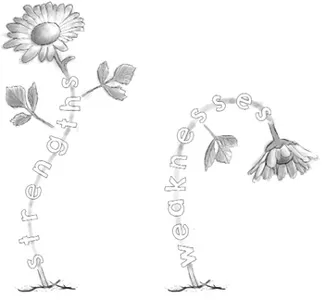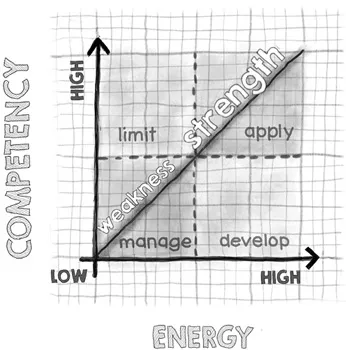![]()
Part I is about how you recognize strengths in yourself and others – what they are (and what they’re not). We provide you with the background of why they matter and how they affect emotions, behaviour and performance. We then cover how to identify and appreciate strengths, both in your organization and in individuals.
Understanding the foundations of this approach will help you to recognize where it is already happening naturally and how to apply it in a flexible way. Although we go on to give you guidance and specific examples of how to apply a strengths-based approach in practice, there will be many other opportunities and variations in how this approach can be applied to produce positive impact. So, knowing enough to start experimenting with both curiosity and courage is the key to success.
![]()
1 What strengths are (and what they’re not)
This chapter defines what strengths are, how it feels to be using your strengths, the difference between strengths and personality, and between strengths and competency-based approaches. We also emphasize that this is about reality and performance – it is not a soft option or a way of avoiding weaknesses.
The terms ‘strengths’ and ‘weaknesses’ have been used freely in education, organizations and society for many years. However, the definitions we use differ in meaning to those in general use (subtly, but in a very important way) and so we want to be clear about the specific definitions that we use in relation to the strengths-based approach.
Our practical definitions are as follows:
A strength is something that, when applied, makes you feel energized and leads to sustainable, good performance.
A weakness is something that, when applied, makes you feel drained and does not lead to sustainable, good performance.
These definitions are closely aligned to those of Cappfinity. They are repeated in Appendix A along with some other terms (such as realized and unrealized strengths) that we use frequently throughout the book.
Your strengths are the natural abilities that you are motivated to use. They are the combination of your characteristics, experience and skills coming together to be applied in an activity which makes you feel your true self and at your best.
When you are using your strengths effectively you will perform well, and you will feel energized and alive. They will be the activities that you most enjoy, the things that you will do first on your to-do list. We are not just talking about what you can do here, but what you love to do – it’s about connecting with the feelings that are generated when you are behaving in a certain way.
In contrast, if you are having to use a weakness area, it will be something that drains your energy. You may be able to perform reasonably well for a limited period of time (you may be competent), but it will leave you feeling tired and flat. Or it may be that you can achieve the outcome you want, but it will take you twice as long as for someone whose strength it is. Using weaknesses does not lead to sustainable, healthy performance.
How to know if you’re using your strengths
Clues that you are applying your strengths:
• What do you feel compelled to do? What do you find yourself volunteering for, because you just can’t help yourself? It may not be something easy, and you may feel trepidation as soon as your hand is up, but you still feel the compulsion to jump in.
• When do you get lost in an activity? When do you lose the concept of time passing, and just feel absorbed in what you are doing? This is sometimes referred to as being ‘in flow’.1
• When do you feel a buzz of energy after an activity, a feeling of having been your best self, your strongest self? So much so that you just want to do it all again?
When you are talking about your strengths, there will be visible signs. You will be more animated, sparkly-eyed. You may change your tone of voice, speak a bit louder, gesticulate more. You may speak faster, smile more and laugh more, be more descriptive, adding colour and emotion. For some people this is very obvious – they have a wider emotional range; for others it is more subtle, and you have to look more closely.
Even within yourself, you may need to tune in to check whether you enjoy something. If you are competent or highly capable at something but the energizing element (feeling) is missing, then it is not a strength.
Chapter 3 contains more guidance on how to identify strengths, including details of online questionnaires which can help. In Appendix B, we have also included Cappfinity’s Strengths Profile dictionary – the 60 potential strengths that are drawn upon in that particular instrument. This gives you an example of the type of language that is used to describe strengths (you could use a highlighter and start to mark those that resonate with you). Throughout the book, if we refer to a strength from this dictionary, it has a capital letter – you can turn to the back to read the definition. There are plenty of other sets of strengths available, but this is the one we use the most because it is so easy to apply.
Below are some important points to further explain what strengths are (and aren’t). In Chapter 2 we discuss the theory and science behind the approach.
Strengths are not the same as personality
Personality is defined by stable characteristics or traits (influenced by genetics), which are established by early adulthood and tend to stay consistent throughout life. This stable aspect of who people are and how they behave is important – humans survive by forming social connections with others and being able to predict behaviour enables that to happen. It can be very helpful to understand personalities, to appreciate preferred styles and the environments/careers that might suit people best. Within teams it is helpful to understand similarities and differences, and to learn to appreciate and value difference rather than have a defensive reaction to it. Considering whether most team members are similar in personality or more diverse is likely to lead to a more balanced approach and is worth doing.
However, the key thing about strengths is the energy element (and this can change over time). While personality traits are just ‘who you are’, strengths are ‘what you love’. There is an overlap with personality – an element of what people enjoy comes from personality, but this enjoyment also comes from experience, success and the positive emotional rewards that result.2 Not only can we discover new strengths over time; we can also develop the ones that we have.
Two people with similar personalities may have different strengths, and two people with different personalities may have similar strengths.
One leadership team we’ve worked with has a very narrow range of personality types – very extroverted, head-over-heart and structured in their work approach. However, their Strengths Profiles are very varied. They think and communicate in similar ways, but where they each invest their energy and what they enjoy is very different.
Strengths are not just competencies or capabilities
Strengths are also different from competencies, and this is the most important shift in thinking that needs to be made in the adoption of a strengths-based approach. Competencies are what people are good at, or capable of doing. It is very common for organizations to have competency frameworks in place, a list of areas that are used to assess performance. They are often used throughout the talent management process – selection, development and promotion – and they have their benefits. For instance, they can be helpful for providing a clear and transparent way of defining pay scales and promotion paths.
However, competencies are not the whole story. Just knowing what people are good at, or capable of, does not tell you what they enjoy doing or are motivated by. You will be good at some things that you just simply don’t get energized by – you may be perfectly competent but get no emotional return from that activity. As people are so fuelled by their emotions (more of this in Chapter 2), this can create a problem. They may get burned out and emotionally drained, or may start avoiding that activity and be far less likely to put in discretionary effort (even though they have the capability).
Competencies can also restrict how you think of people. Do you want an organization full of people who have a high level of capability, but no natural motivation to deliver? Do you want to ignore an area where someone could be brilliant, but doesn’t fit into the framework? Competency frameworks, if used blindly, can have the consequence of flatlining performance – driving towards an organization of average performers, rather than rewarding and encouraging the (less uniform) sparks of brilliance.
Competency matters, but strengths matter more.
Competency matters, but by increasing the proportion of time you spend on activities that you also find energizing, you will get more sustainable high performance (as well as improved wellbeing).
The aim is to shift the focus from an activity that someone is purely capable of to an activity that also aligns with their values and who they are. The term ‘strengths’ is common in organizations but is still often used to refer to capability alone, for example, when used within appraisal feedback or 360o surveys. However, here we are referring to whether someone is capable and gets a positive emotional return and uplift in energy.
For inclusivity, wellbeing and sustained performance you should apply your strengths whenever you can – do what you find energizing and are competent at. You should limit how much time you spend on activities that you are competent at but do not find energizing – it is especially important to consider this when making career choices, so that you look after your wellbeing. You should develop the activities that energize you in order to increase your competence. Finally, you should manage your weaknesses.
Using strengths is not a way of avoiding weaknesses
The world is not perfect (and nor are we), so knowin...



